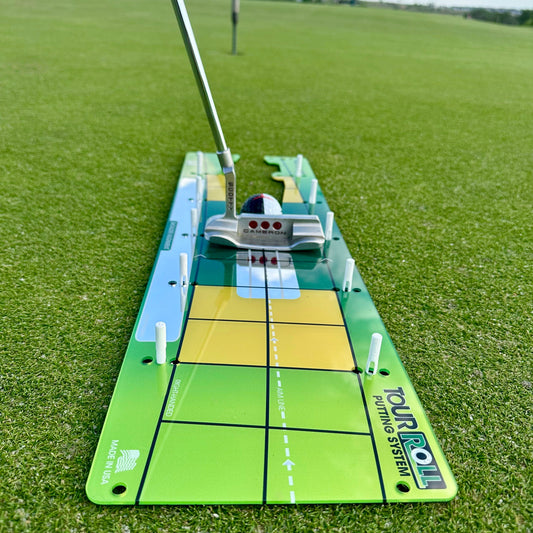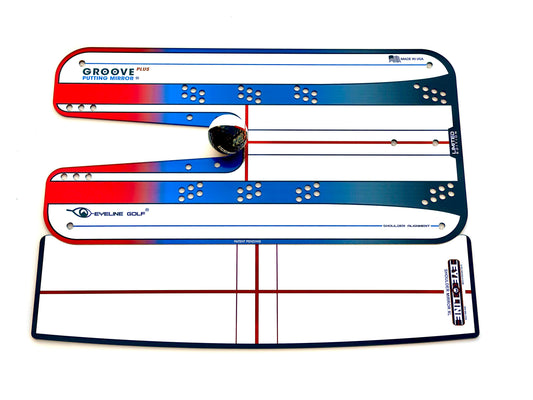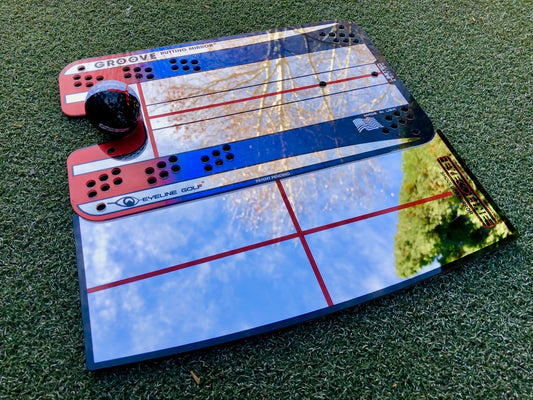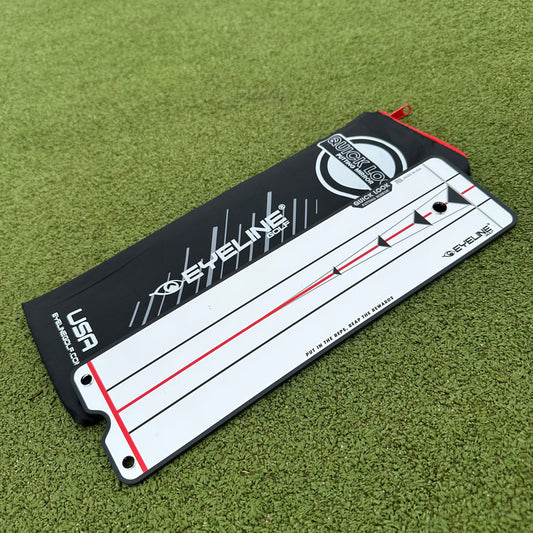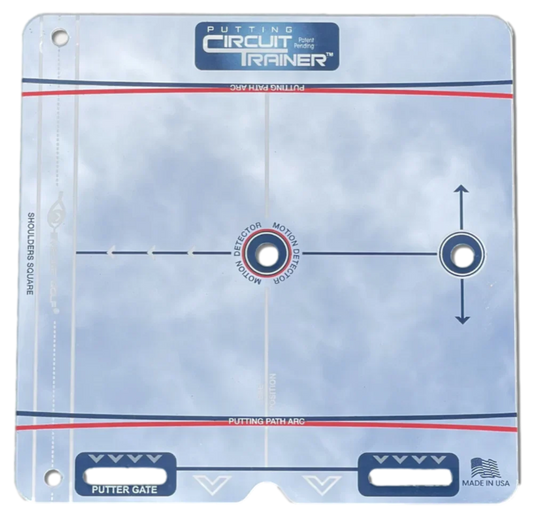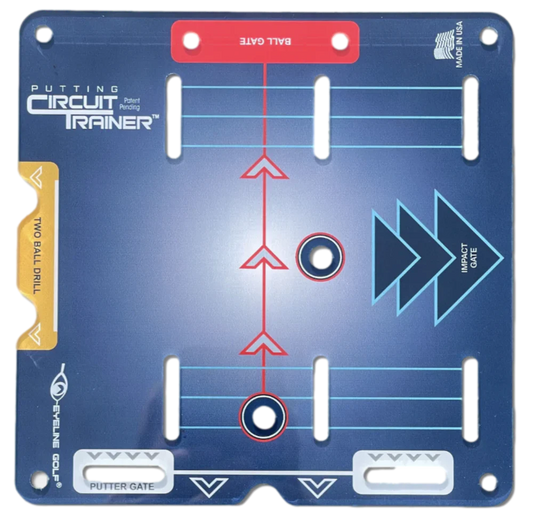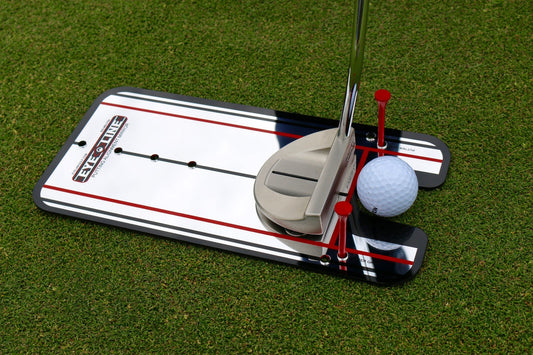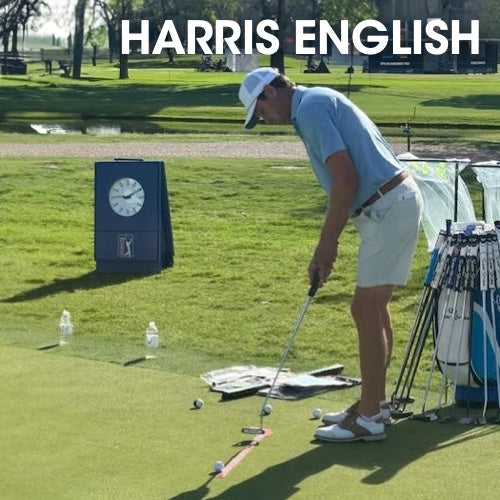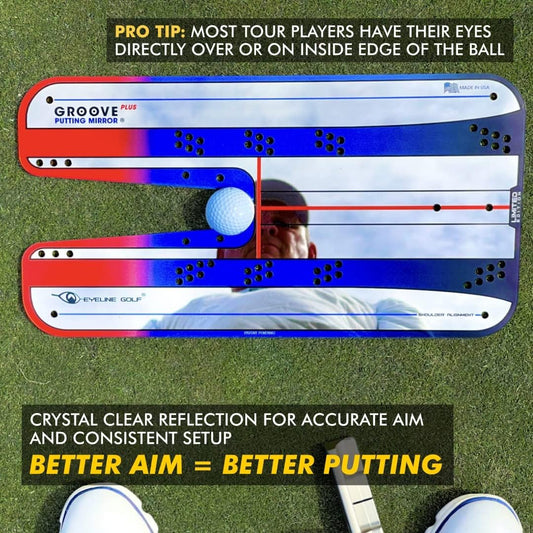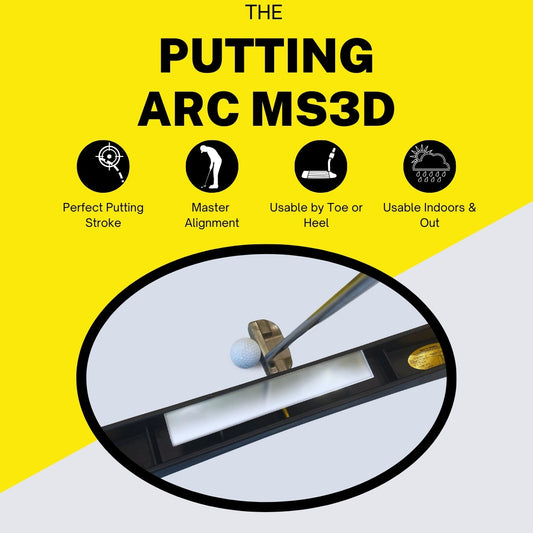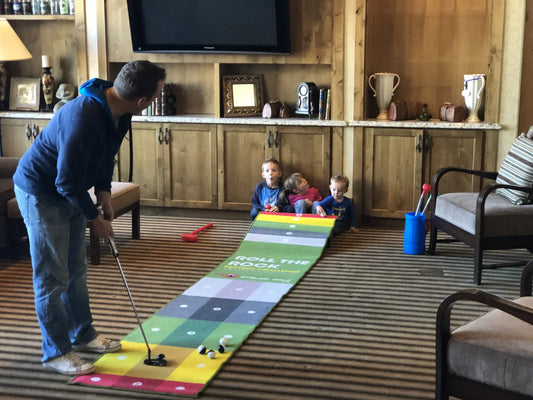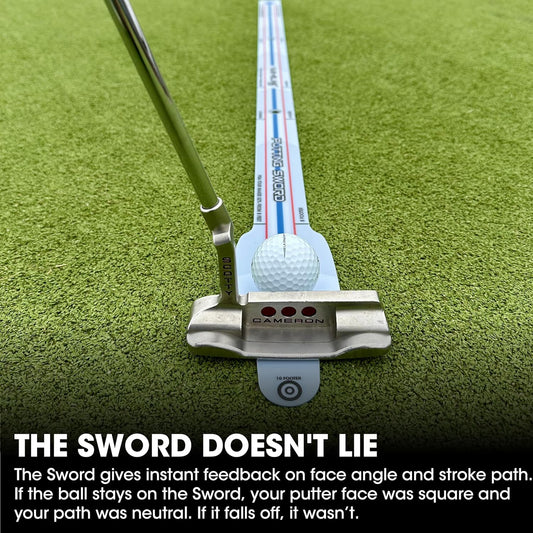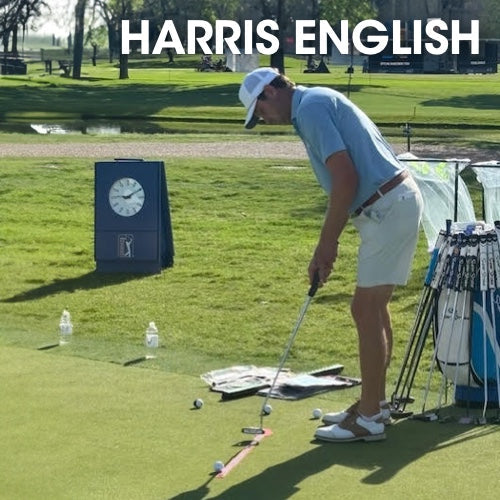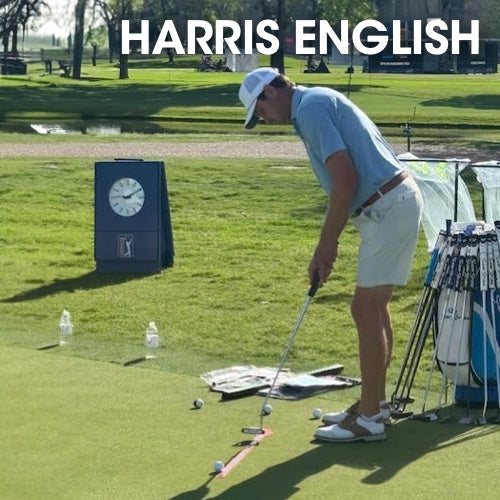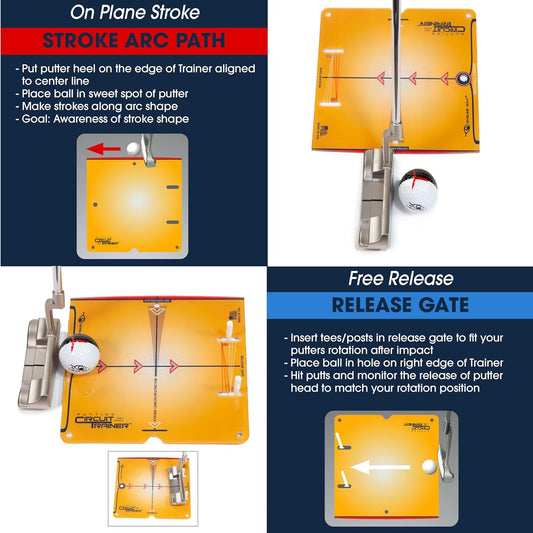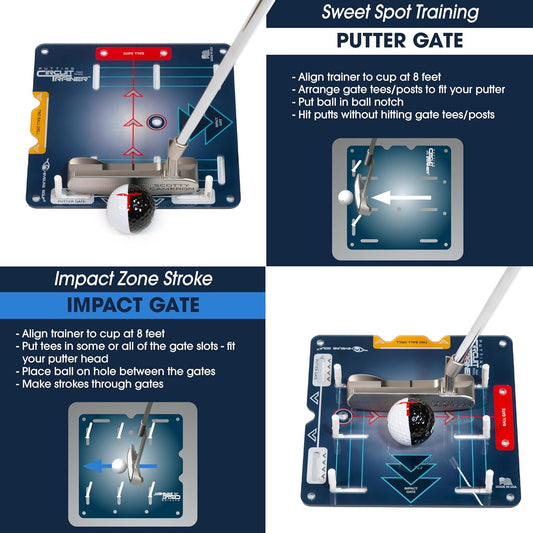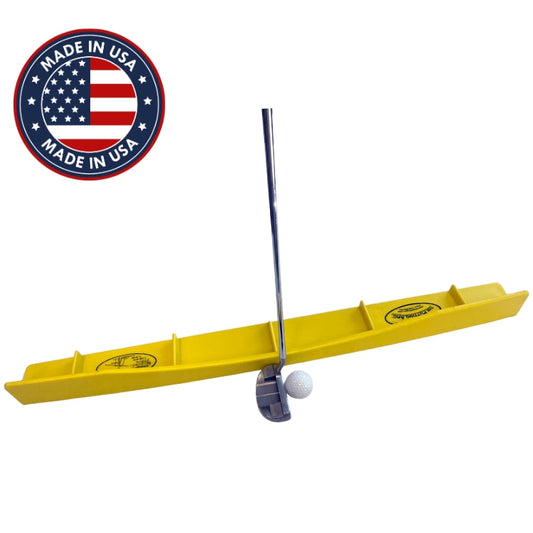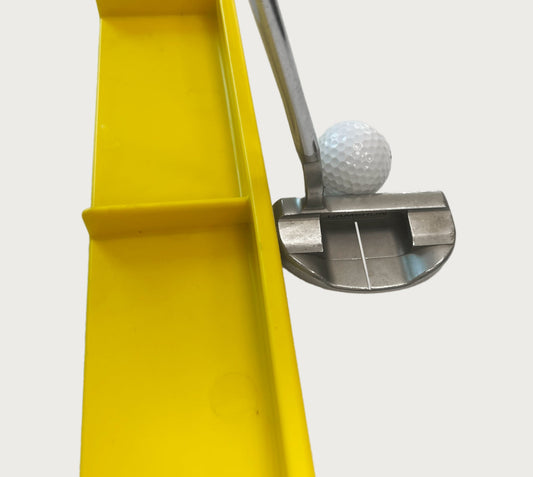Blackout Putter System
Feel Gets Real. Trust Gets Trained.
Free your mind when it’s time to perform — shifting your thinking to training.
Do you ever practice your Putting stroke on the practice green and dream about making Putts on game day?
You know, Putting a golf ball on the course without technical thoughts is possible. But right now, grinding on the fundamentals to make sure you're doing it correctly seems like the right thing to do.
Seems like you've spent forever and a day working on your Putting stroke.
When what you really want is to stop 3-Putting, make your short Putts consistently, and improve your golf score. But how do you do that without all those technical thoughts on the practice green, thinking your way through the process?
You know it’s possible to roll a Putt without thinking about the Fundamentals of the Putting stroke.
To pull the trigger without thinking about the speed and direction and all that technical stuff. But how do you get there? What if you could go play golf without the worry because you know you've done the work and preparation to Putt this way?
Ask yourself: how would your golf score change if you could roll your Putts the correct distance without the over-focus on direction? Because right now, you’re throwing strokes away. You’re hurting the rest of your golf game.
You're starting to realize that all good Putters have great distance control.
Lately, it’s becoming clearer than ever that if you want to lower your score you have to get the distance right and stop 3-Putting. Deep down you feel like you’re finally ready to to shut out all thoughts and focus on instead on where you want the ball to go.
Imagine what it would be like to address the ball and be in control of your thoughts. Not just on the first green. All the way through the round. Refuse to allow any negative thought to enter your head, and roll the ball.
When you’re honest with yourself, you know you could become a good Putter. You see other players at the club that are confident and focused even under pressure or when there's a little chatter going on. You also notice the rhythm and routine never changes.
You notice they miss Putts too. They miss a little left or right but hardly ever missing way short or dreadfully long. It seems all good Putters have great distance control. You know it’s your time to take control of your scoring game.
You’ve reached the point where you KNOW becoming a good Putter is possible. And there’s no better time than now. You know grinding over fundamentals hasn’t worked before. And you’re ready to do whatever it takes to get the ball in the hole as quickly as possible.
There’s got to be a better way, Right?
Good news: There’s a way, and this is it.
When you’re at that point where you want to be a good Putter but don't know how to get there. There’s a way to ingrain the Putting fundamentals to memory, then and only then Putt without the thought of direction, speed of the green, or trying not to miss.
No thoughts of anything technical. Not even one.
What you’ve tried before? You didn’t have this ability to Putt a golf ball the correct distance without the thought of how hard to strike the ball. That’s why I’m sharing a better way to practice and prepare for game day.
How many times have you “found something” in your Putting stroke that works, and then that’s all you can think about?
Here's the real problem. Just like the golf swing, we find something that works, then we go to the practice green, and ingrain that 'swing thought' into our conscious memory.
Then we go play golf.
In those few seconds right before we pull the trigger, the new thought is barking instructions at us. Before the round is over, your lost and confused again.
I can talk from experience, anxiety kicks in and it's impossible to play good golf this way. My 'back to the drawing board' style of Putter Training almost ended my dream of becoming a good Putter. Then I found the answer, that's when Putting practice changed.
As luck would have it, it happened on the driving range not the practice green.
Meet the moment of truth behind Blackout Mode.
A while back, ok it was over 20 years ago, I was reading an article in Golf Digest about how Phil Mickelson practices distance control with his wedges.
Phil would work on 1-yard intervals, yes, I said 1-yard. He would have his caddy stand at say 85 yards, with a baseball glove. Phil would hit his wedge shot so his caddy could catch the golf ball without moving his feet.
My interest was piqued!
His caddy would take one step back and Phil would hit 86-yard shots. He would go through all yardages; each time feeling the difference at 1-yard intervals.
Incredible!
Then it hit me, “I’m practicing the wrong things.” Phil was not working on his swing, most likely no swing thoughts were dancing in his head. His only thought was to hit the golf ball to his caddy 86-yards away.
Think about that for a moment, we are grinding on the range, shot after shot, trying to fix our golf swing.
Then here’s Phil Mickelson, hitting little wedge shots 85-yards, then 86-yards, then 87-yards, his only thought was the distance to the baseball glove?
I had questions.
How does he do that?
What’s the difference between 85-yards and 86-yards, in the golf swing?
Does he consciously change the mechanics of any part of his swing?
This was the decisive moment for me, it changed everything. It changed how I practice on the range, how I practice on the green, how I practice at home, and most importantly, how I prepare for game day.
You know what I've noticed in Putting through-out the years?
All good Putters have great distance control. There are two variables in Putting: distance and direction. Most players over-focus on direction and under-feel distance.
Just like Phil Mickelson hitting 1-yard intervals with his wedges, the only way to control distance with the Putter is to eliminate thought of how hard to strike the ball. I know, seems backwards.
You hear announcers talk about it all the time; how good their Feel is.
The common denominator of the best putters in the world is that in the moments right before they pull the trigger, they’re not thinking about anything. Top players and teachers have different names for it, separate ways to get into that mode:
Harvey Penick (Little Red Book) called it “TAKE DEAD AIM.”
Brian Hepler (Tathata Golf) calls it “LOOKING OUT IN FRONT.”
Jordan Spieth calls it “BLACKOUT.”
Tiger Woods calls it “TAKE A PICTURE.”
Simply, it’s about rolling a golf ball without thought, with the image of the target fresh in your mind. The target represents the distance while the mental image feeds valuable information to the brain.
Introducing...
Blackout Putter Training
This is the Practice Plan that teaches how to Feel the distance without grinding over the Putting fundamentals. A perfect compliment to Fairway Wedge Training.
A practice strategy that lowers your score!
Checkout What's Inside
-
Training Starts At Home
We’ll build an in-home training habit while introducing the fundamentals of the pre-putt routine, the 7-steps to a perfect setup, and the 8-steps to the putting stroke. The drills are short, easy to understand and simple to do. We'll install muscle memory before we go to the practice green.
-
Feel Drills on the Green
We can now focus our attention towards “how to make more Putts” and getting the distance right. This is where we move past any mechanical thought of right or wrong and start the process of Feeling the roll of the ball. We start the process of preparing your pre-putt routine for game day.
-
How to Change Speeds
You'll learn how to change the speed of your putting stroke to adjust the distance the ball rolls. We'll commit the fundamentals of changing speeds to memory, so we don’t have to think about the process once we get on the practice green. A key moment in your training.
-
Your Own Practice Plan
Going to the Practice Green without a plan, grinding over making putts, is not practice, and has little value. A great advantage to In-Home Training is you can evaluate your performance on the practice green or your round. Identify your strengths and weaknesses. The next practice plan encourages you to keep moving forward with your training.
-
Advanced In-Home Training
I'll encourage you to STOP working on your Putting fundamentals on the Putting green. But, if you’re anything like me, sometimes you start fixing your stroke at the course. I'll show you how handle it without old habits returning, you know, trying to fix your putting stroke while on the practice green. Or worse yet, while playing your round.
-
Building Implicit Memory
Skilled typists rely on implicit muscle memory to locate letters on the keyboard without conscious thought of where the letters are located. In Putting terms, implicit memory involves remembering the fundamentals of how-to set up to the ball and roll it without consciously thinking about how to do it. This is how we get the distance right.
What does Jordan Spieth see when he steps into a putt?
“The blur of the ball’s path and that path alone burns in my mind – nothing else. My stroke is simply a reaction to make that path come alive, to come to be, with the roll of the ball.”
Jordon also said that “it takes Work and Preparation to get in this mode,” a mode he calls “BLACKOUT.”
Jordon Spieth (with Max Adler, Golf Digest) June 20, 2017
When Jordon Spieth steps into a putt, the only thing he is thinking about is the blur of the ball’s path. The important part is it’s the only thing, and nothing else. Jordon talked about how it takes work and preparation to putt this way.
The work and preparation will start at home, where you’ll ingrain the putting fundamentals to memory.
Fundamentals Start at Home
Blackout Putter System
The Putter will make your confidence soar like no other club in the bag. The Putter is the last club you use on virtually every hole you play. It can make or break your attitude for the next hole. When you walk to the next hole feeling good about making Putts, your tee ball improves by default.



Tiger says:
“Every look I take from the ball is a picture. First look I
take a picture of the hole, get up over the ball, look at the hole, take another picture, another look and take a last picture. Then I Putt to the picture. That really helps free my mind. Don’t have to worry about distance because all I’m doing is Putting to the picture. It really helps me late in the round when I’m under pressure.”
Once the correct putting fundamentals are committed to memory, you’ll know it, you’ll be able to Feel it, when done correctly. You’ll be able to perform the drills without
conscious thought of right or wrong. You’ll know when you’re ready for on course drills, this is where practice becomes fun. There is nothing like this feeling in golf, to stroke a putt the perfect distance without thought.
This is where you’ll discover your own way of getting into Blackout Mode in the seconds
just before you pull the trigger.
I can speak from experience, "It Changes Everything!"
Blackout Putting Mirrors
Blackout Putting Alignment Mirrors helps you position your eyes where you can see the line of the putt accurately, ensuring consistent setup every time you stand over the ball. Whether directly over the ball or just inside, the mirror enables you to find your ideal eye position for better putt accuracy.
-
Tour Roll Putting Mirror Trainer
Vendor:EyeLine GolfRegular price $79.95 USDRegular price$99.95 USDSale price $79.95 USDSale -
Shoulder Mirror for EyeLine Classic Putting Mirror & Groove PLUS Mirror (large)
Vendor:EyeLine GolfRegular price From $39.95 USDRegular price$39.95 USDSale price From $39.95 USD -
Shoulder Mirror - Groove and Putting Alignment Mirror (small)
Vendor:EyeLine GolfRegular price $29.95 USDRegular price$29.95 USDSale price $29.95 USD -
Quick Look Mirror
Vendor:EyeLine GolfRegular price $29.95 USDRegular price -
PUTTING CIRCUIT TRAINER - MIRROR TRAINER
Vendor:EyeLine GolfRegular price $49.95 USDRegular price$49.95 USDSale price $49.95 USD -
PUTTING CIRCUIT TRAINER - 3 PART SYSTEM (SAVE $40)
Vendor:EyeLine GolfRegular price $79.95 USDRegular price$119.95 USDSale price $79.95 USDSale -
Putting Alignment Mirror | Setup and Alignment
Vendor:EyeLine GolfRegular price From $39.95 USDRegular price -
New - Groove Plus Putting Mirror
Vendor:EyeLine GolfRegular price $79.95 USDRegular price -
Groove Putting Mirror + Putting Sword Pair
Vendor:EyeLine GolfRegular price $109.90 USDRegular price$139.90 USDSale price $109.90 USDSale -
Groove Plus Putting Mirror
Vendor:EyeLine GolfRegular price From $74.95 USDRegular price$89.95 USDSale price From $74.95 USDSale -
Edge Putting Rail | Quick Look Mirror Combo
Vendor:EyeLine GolfRegular price $79.95 USDRegular price$89.95 USDSale price $79.95 USDSale -
Classic EyeLine Putting Mirror (Large)
Vendor:EyeLine GolfRegular price From $59.95 USDRegular price$59.95 USDSale price From $59.95 USD
Blackout Putting Training Aids
Blackout golf will continue to introduce you to top-tier, impactful Putting Aids. We’re committed to bringing you the tools and knowledge to install Blackout Mode into your game, so you're not thinking about the process of doing it correctly on game day.
-
The Putting Arc | Square at Impact
Vendor:Golf Training AidsRegular price $29.99 USDRegular price$49.99 USDSale price $29.99 USDSale -
The Putting Arc | hit every putt square
Vendor:Golf Training AidsRegular price $74.99 USDRegular price$89.99 USDSale price $74.99 USDSale -
ROLL THE ROCK PUTTING MAT - 8 FOOTER
Vendor:EyeLine GolfRegular price $79.95 USDRegular price$89.95 USDSale price $79.95 USDSale -
Roll the Rock Putting Challenge Mat (10'x2')
Vendor:EyeLine GolfRegular price $199.95 USDRegular price$224.95 USDSale price $199.95 USDSale -
Putting Sword by Michael Breed - Standard Model
Vendor:EyeLine GolfRegular price $39.95 USDRegular price -
Putting Sword 2.0 by Michael Breed - Tour Model
Vendor:EyeLine GolfRegular price $39.95 USDRegular price$39.95 USDSale price $39.95 USD -
Putting Sword 2.0 by Michael Breed - Pair (Standard & Tour Model)
Vendor:EyeLine GolfRegular price $59.95 USDRegular price$79.90 USDSale price $59.95 USDSale -
PUTTING CIRCUIT TRAINER - YELLOW TRAINER
Vendor:EyeLine GolfRegular price $34.95 USDRegular price$34.95 USDSale price $34.95 USD -
PUTTING CIRCUIT TRAINER - MIRROR TRAINER
Vendor:EyeLine GolfRegular price $49.95 USDRegular price$49.95 USDSale price $49.95 USD -
PUTTING CIRCUIT TRAINER - BLUE TRAINER
Vendor:EyeLine GolfRegular price $34.95 USDRegular price$34.95 USDSale price $34.95 USD -
PUTTING CIRCUIT TRAINER - 3 PART SYSTEM (SAVE $40)
Vendor:EyeLine GolfRegular price $79.95 USDRegular price$119.95 USDSale price $79.95 USDSale -
Putting Arc | Keep Putter on Plane
Vendor:Golf Training AidsRegular price $59.99 USDRegular price$79.99 USDSale price $59.99 USDSale



